How to choose a tile in the kitchen, and which in the bathroom - we solve the dilemma
We can confidently say that ceramic tile is the most attractive and popular finishing material. This is the undisputed leader, characterized by a limitless assortment that can satisfy the most demanding tastes. A variety of styles, colors, technical parameters - you can easily get lost in all this variety, finding yourself in a very difficult situation: how to choose a tile in the bathroom, and which is better to buy for the kitchen? To dispel all doubts and help make the right decision, this article has been written.
Content
Features of the choice of kitchen tiles
The first selection criterion is the purpose of the room, since you cannot use the same tile as the cladding of different rooms. Therefore, before deciding which tile to choose, it is necessary to analyze the operational performance of specific rooms.
The kitchen is the “face” of the hostess, because there they not only prepare dishes, but also hold family breakfasts or just have friendly conversations. This means that you need to choose the right tile so that it is not only functional, but also comfortable.
Many people do not see the difference between the concepts of “technical specifications” and “tile quality”. These are completely different things, because of such ignorance you can, for example, overpay money by buying frost-resistant ceramic tiles of the fifth resistance class. Yes, this is not at all funny, because such material is placed on the street or in freezers.
Important: for the kitchen, tiles of the third class of wear resistance are enough. Plus, money in your pocket and quality will not suffer.
It is clear that there is no frost in the kitchen, however, the tiles will still be tested, but not so severe. It is necessary to carefully study the inscriptions on the box with tiles and pay attention to the icons. From these inscriptions you can draw a lot of useful information, for example, a hand on a black background - a tile designed for walls, a leg on a similar background - a floor covering.

The kitchen belongs to the type of premises with constant changes in humidity: water and evaporation, which are released during cooking. First, the pairs fall into the thickness of the tile, then into the depths of the walls. Based on these considerations, it becomes clear that the tile for the kitchen should have a low rate of water absorption (not more than 5%).
The next moment - there is no secret that the tiles in the kitchen quickly get dirty. This leads to the frequent use of household chemicals, therefore, tile should be susceptible to various chemicals. Category A is suitable for a kitchen room, that is, a minimal impact, but it is better to buy a tile of category AA. The second option does not undergo chemical reactions at all, the waterproof properties are not violated, the decorative layer serves for a long time.
Another aspect - the basis of the tiles for the kitchen is more porous and with a thick layer of glaze. These qualities give the material increased refractory properties, as well as resistance to temperature extremes. This is especially true in the cooking area.

Also, an important technical characteristic is the degree of wear resistance, this applies more to flooring. There are five classes of tiles; a third class is suitable for the kitchen. You can buy 4 and 5 class, but this is just an extra, aimless waste of money.
The floor in the kitchen is often dirty, when choosing, you should take into account the reflection coefficient of the glazed coating. There are several nuances here:
- dirt is less noticeable on a dark tile with a granular structure;
- if glare and reflection are undesirable, it is better to buy a matte tile;
- chips and scratches are most striking on the black glossy tiles.
You can come to a logical conclusion - when buying tiles, you need to be guided not only by a personal “I want”, but also take into account the laws of physics.
Tile selection criteria for the bathroom
Bathroom - a special room in which not only wash, but also cosmetic procedures. Therefore, comfort and convenience come first. And the general requirements are as follows: maximum moisture resistance, high resistance to chemical cleaning agents, household chemicals, excellent ability to withstand temperature extremes, prolonged exposure to steam, as well as a stable color of glaze, resistance to fading.
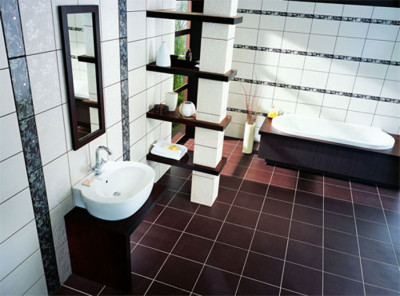
As for the flooring, it is better to lay the tiles with anti-skid, because almost always the floor is wet in this room. Loss of balance on a slippery surface can result in bruises and even injuries. To avoid such dangerous situations, it is advisable to clad the floor with embossed or structured tiles with a matte surface.
Important: to prevent destructive moisture from entering tile joints, rectified tiles should be laid.
A small selection of design solutions
A very interesting solution is the interior of the bathroom in the Japanese style, it conquers with calm and contemplation.
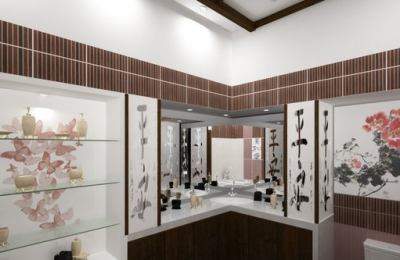
If such an exquisite tile cannot be found, you can replace it with plain tiles with delicate shades: sand, beige, milk, white. Warm colors will give the bathroom a cozy atmosphere, and red, green tiles can be used as accents.
Important: in the Japanese style, preference is given to natural colors, muted shades, prim brightness is absolutely not suitable.
The familiar design of the bathroom is now not in fashion, today there are many original combinations, patterns and decor elements. The modern range of tiles provides ample opportunities for experimentation - the play of colors, a visual increase in space.
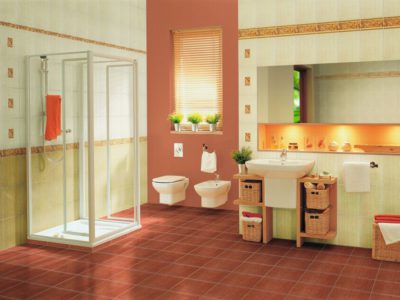
Fantasy can also be used in the kitchen. It is desirable that the tile is in harmony with the countertop, furniture set or, on the contrary, in sharp contrast. It is the tile that can become a bright accent that will turn an ordinary kitchen into a stylish room.
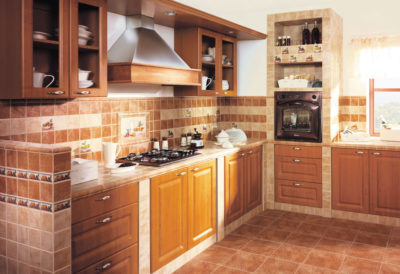
Designers recommend using solid colors in the kitchen, simple lines.It is better to avoid a "torn" pattern, frequent joints and tile under a tree will also look bad. But, however, the modern design is very democratic, so you can choose the tile at your discretion, if only it fits seamlessly into the interior.
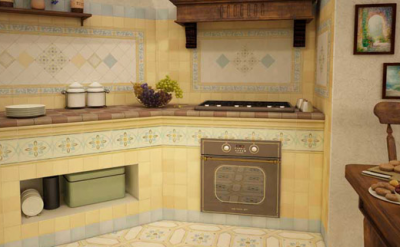
Country style kitchen - a solution worthy of attention. Hand-painted tiles with jagged edges or “broken” into pieces look great. From such a unique tile you can lay out a pattern that will not be found anywhere else.
How to check tiles for quality performance?
In order for the tile to serve for a long time, when choosing, do not forget about quality, because you can not save on it:
- on the tile should not be fading, stains;
- side faces should be flat. This is easy to verify: you need to connect two tiles with side faces and inspect the joint - the gap should not exceed 0.5 mm. But on the tile, which is designed for seamless installation, no clearance is observed at all;
- there are no cracks on the back side, there should also be no chips.
Important: the embossed surface of the back side of the tile is an additional plus, providing better adhesion to the bottom layer.
If you understand all the issues well and approach the choice of tiles wisely, you can choose the perfect finishing material.

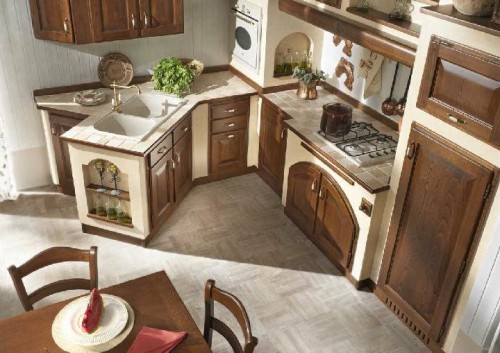

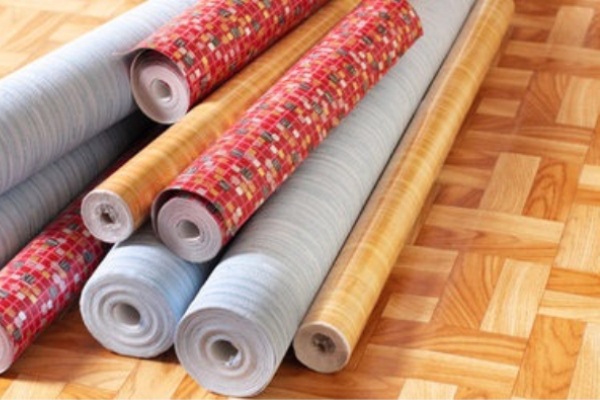
3 comments